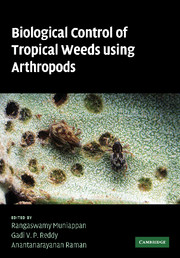Book contents
- Frontmatter
- Contents
- List of contributors
- Acknowledgments
- 1 Biological control of weeds in the tropics and sustainability
- 2 Acacia nilotica ssp. indica (L.) Willd. ex Del. (Mimosaceae)
- 3 Australian Acacia species (Mimosaceae) in South Africa
- 4 Ageratina adenophora (Sprengel) King and Robinson (Asteraceae)
- 5 Azolla filiculoides Lamarck (Azollaceae)
- 6 Cabomba caroliniana Gray (Cabombaceae)
- 7 Invasive cactus species (Cactaceae)
- 8 Chromolaena odorata (L.) King and Robinson (Asteraceae)
- 9 Clidemia hirta (L.) D. Don (Melastomataceae)
- 10 Coccinia grandis (L.) Voigt (Cucurbitaceae)
- 11 Eichhornia crassipes (Mart.) Solms–Laub. (Pontederiaceae)
- 12 Lantana camara Linn. (Verbenaceae)
- 13 Mimosa diplotricha C. Wright ex Sauvalle (Mimosaceae)
- 14 Mimosa pigra L. (Leguminosae)
- 15 Parthenium hysterophorus L. (Asteraceae)
- 16 Passiflora mollissima (HBK) Bailey (Passifloraceae)
- 17 Pistia stratiotes L. (Araceae)
- 18 Prosopis species (Leguminosae)
- 19 Salvinia molesta D. S. Mitchell (Salviniaceae)
- 20 Solanum mauritianum Scopoli (Solanaceae)
- 21 Application of natural antagonists including arthropods to resist weedy Striga (Oranbanchaceae) in tropical agroecosystems
- 22 Biological control of weeds in India
- 23 The role of International Institute of Tropical Agriculture in biological control of weeds
- 24 The role of Secretariat of the Pacific Community in the biological control of weeds in the Pacific Islands region – past, present, and future activities
- Index
3 - Australian Acacia species (Mimosaceae) in South Africa
Published online by Cambridge University Press: 04 August 2010
- Frontmatter
- Contents
- List of contributors
- Acknowledgments
- 1 Biological control of weeds in the tropics and sustainability
- 2 Acacia nilotica ssp. indica (L.) Willd. ex Del. (Mimosaceae)
- 3 Australian Acacia species (Mimosaceae) in South Africa
- 4 Ageratina adenophora (Sprengel) King and Robinson (Asteraceae)
- 5 Azolla filiculoides Lamarck (Azollaceae)
- 6 Cabomba caroliniana Gray (Cabombaceae)
- 7 Invasive cactus species (Cactaceae)
- 8 Chromolaena odorata (L.) King and Robinson (Asteraceae)
- 9 Clidemia hirta (L.) D. Don (Melastomataceae)
- 10 Coccinia grandis (L.) Voigt (Cucurbitaceae)
- 11 Eichhornia crassipes (Mart.) Solms–Laub. (Pontederiaceae)
- 12 Lantana camara Linn. (Verbenaceae)
- 13 Mimosa diplotricha C. Wright ex Sauvalle (Mimosaceae)
- 14 Mimosa pigra L. (Leguminosae)
- 15 Parthenium hysterophorus L. (Asteraceae)
- 16 Passiflora mollissima (HBK) Bailey (Passifloraceae)
- 17 Pistia stratiotes L. (Araceae)
- 18 Prosopis species (Leguminosae)
- 19 Salvinia molesta D. S. Mitchell (Salviniaceae)
- 20 Solanum mauritianum Scopoli (Solanaceae)
- 21 Application of natural antagonists including arthropods to resist weedy Striga (Oranbanchaceae) in tropical agroecosystems
- 22 Biological control of weeds in India
- 23 The role of International Institute of Tropical Agriculture in biological control of weeds
- 24 The role of Secretariat of the Pacific Community in the biological control of weeds in the Pacific Islands region – past, present, and future activities
- Index
Summary
Introduction
Acacia, sensu lato, is a large and cosmopolitan genus containing some 1350 described species (Ebinger et al., 2000; Orchard and Wilson, 2001; Maslin et al., 2003; Orchard and Maslin, 2003; www.worldwidewattle.com). This genus is associated in particular with savannas and open woodlands in the tropical, subtropical and warm temperate parts of the world. The highest number of species occurs in Australia, followed by the Americas and Africa, and to a lesser extent in Asia (Ross, 1981; Maslin, 2001). They are also found in parts of Indonesia and islands in the Pacific and Indian oceans, and although possibly present in New Zealand millions of years ago, only naturalized Australian species now remain there.
The acacias all belong to the family Mimosaceae. The taxonomy of the genus has been revised several times over the last 30 years, most notably by Vassal (1972) and Pedley (1978, 1986), and more recently by Seigler and Ebinger (2005) and Seigler et al. (2006). The genus was formally described in 1754, being based on the African species Acacia nilotica (Linn.). The word “acacia” was derived from the Greek word akis meaning “sharp point,” referring to the spiny stipules which are characteristic of A. nilotica. Historically their classification was based on morphological characteristics of the inflorescences and foliage; however, more recent descriptions consider chemical, pollen, seed, and germination traits (Evans et al., 1977; New, 1984).
The genus currently comprises three subgenera, Acacia, Aculeiferum, and Phyllodineae, each differing substantially in their geographic distributions and biological characteristics.
- Type
- Chapter
- Information
- Biological Control of Tropical Weeds Using Arthropods , pp. 38 - 62Publisher: Cambridge University PressPrint publication year: 2009
- 19
- Cited by

